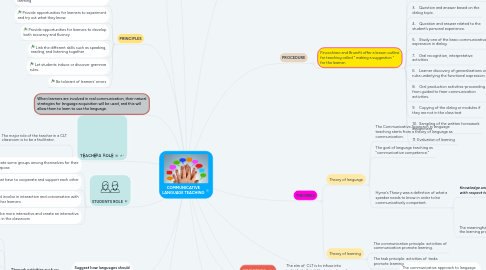
1. No set method for structuring lessons, instead, provides a theory of how languages are best learned.
2. Suggest how languages should be taught.
2.1. Through activities such as:
2.1.1. Simulation games (role playing)
2.1.2. Interviews
2.1.3. Exchange of information distributed among students
2.1.4. Language exchange
2.1.5. Polls
2.1.6. Work in pairs
2.1.7. Learn by teaching
3. PRINCIPLES
3.1. Make real communication the focus of language learning
3.2. Provide opportunities for learners to experiment and try out what they know
3.3. Provide opportunities for learners to develop both accuracy and fluency
3.4. Link the different skills such as speaking, reading, and listening together
3.5. Let students induce or discover grammar rules.
3.6. Be tolerant of learners’ errors
4. TEACHERS ROLE
4.1. The major role of the teacher in a CLT classroom is to be a facilitator.
4.1.1. To stablish conditions and develop activities, so students will be able to practise.
4.1.1.1. Interpreter and designer of learnig programmes and materials.
5. ADVANTAGES
5.1. Communicative approach is much more pupil-orientated, because it is based on pupils’ needs and interests.
5.2. Communicative approach seeks to personalise and localise language and adapt it to interests of pupils.
5.3. Seeks to use authentic resources. And that is more interesting and motivating for children.
5.4. Children acquire grammar rules as a necessity to speak so is more proficient and efficient.
6. Is based on the idea that learning language successfully comes through having to communicate real meaning.
7. When learners are involved in real communication, their natural strategies for language acquisition will be used, and this will allow them to learn to use the language.
8. STUDENTS ROLE
8.1. Have to create some groups among themselves for their learning purpose
8.2. The students must have to cooperate and support each other in the group
8.3. The learners should involve in interaction and conversation with the teacher and other learners
8.4. They should be more interactive and create an interactive environment in the classroom
9. The communicative approach to language teaching starts with the theory of language as communication.
10. The student focuses on fluency but not precision, and this causes them to make incoherent and grammatically incorrect sentences.
11. OBJECTIVES
11.1. The aim of CLT is to infuse into individuals the ability to create and construct utterances.
12. DISAVANTAGES
12.1. It pays insufficient attention to the context in which teaching and learning take place.
12.2. The difficulties have the native speakers to understanding students
13. PROCEDURE
13.1. Finocchiaro and Brumfit offer a lesson outline for teaching called “ making a suggestion “ for the learner:
13.1.1. 1. Presentation of a brief dialog or several mini-dialogs.
13.1.2. 2. Oral practice of each utterance of the dialog segment to be presented that day.
13.1.3. 3. Question and answer based on the dialog topic.
13.1.4. 4. Question and answer related to the student’s personal experience.
13.1.5. 5. Study one of the basic communicative expression in dialog.
13.1.6. 7. Oral recognition, interpretative activities
13.1.7. 6. Learner discovery of generalizations or rules underlying the functional expression.
13.1.8. 8. Oral production activities-proceeding from guided to freer communication activities.
13.1.9. 9. Copying of the dialog or modules if they are not in the class text
13.1.10. 10. Sampling of the written homework assignment
13.1.11. 11. Evaluation of learning
14. THEORIES
14.1. Theory of language
14.1.1. The Communicative Approach in language teaching starts from a theory of language as communication.
14.1.2. The goal of language teaching as “communicative competence.”
14.1.3. Hyme's Theory was a definition of what a speaker needs to know in order to be communicatively competent.
14.1.3.1. Knowledge and ability for language use with respect to.
14.1.3.1.1. 1. Whether something is formally possible.
14.1.3.1.2. 2. Whether something is feasible in virtue of the means of implementation available.
14.1.3.1.3. 3. Whether something is appropriate in relation to a context in which it is used and evaluated.
14.1.3.1.4. 4. Whether something is in fact done, actually performed, and what its doing entails.
14.1.3.2. The meaningfulness principle: Supports the learning process to learner.
14.2. Theory of learning
14.2.1. The communication principle: activities of communication promote learning.
14.2.2. The task principle: activities of tasks promote learning.
